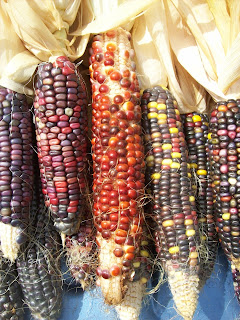Herbcraft, foraging, wildcrafting, herbs, botany, bugs, creatures, genealogy, organic gardening and whatever else that takes my fancy, including altered books, dance, frugality, tightwaddery, and the like.
Thursday, October 3, 2013
When corn is treasure
Hanging indoors to dry.
Corn smut.
Possibly the best-looking ear, based on what I sorted the seed by.
No idea where this color came from, LOL
Moth Day Oct. 2
This is an Alfalfa looper, Autographica californica.
It is most common from southern British Columbia to southern Saskatchewan and south to the border with Mexico. This species is a generalist feeding on a wide variety of herbaceous plants, but appears to prefer legumes (Fabaceae) (alfalfa).
It is mostly found in May, late July and late September.
 This is a Lophocampa maculata, the Mottled tussock moth.
This is a Lophocampa maculata, the Mottled tussock moth.
It ranges across southern Canada, western US, south in Appalachians to South Carolina, Kentucky. It likes deciduous forests. Adults (usually) fly from May to July and the tufted caterpillars are from July to September. They prefer leaves of poplar and willow, but also feed on alder, basswood, birch, maple, oak.

Beautiful mosaic on the lower border of its wings.
This one has a hammerhead pattern on it. Hard to know if that's a shape or a coloration. Very good-looking.
There were some I haven't identified!
... another bark-colored moth
This one was flitting around quite vigorously. So fast that I was simply lucky to get this good of a photo of it, about center.
It is most common from southern British Columbia to southern Saskatchewan and south to the border with Mexico. This species is a generalist feeding on a wide variety of herbaceous plants, but appears to prefer legumes (Fabaceae) (alfalfa).
Adults frequently visit flowers for nectar in open meadow habitats during the day. They are most commonly collected during the night and come readily to lights. They have been collected at almost all times of the year, beginning in February and extending to the end of November.
It is mostly found in May, late July and late September.
 This is a Lophocampa maculata, the Mottled tussock moth.
This is a Lophocampa maculata, the Mottled tussock moth.It ranges across southern Canada, western US, south in Appalachians to South Carolina, Kentucky. It likes deciduous forests. Adults (usually) fly from May to July and the tufted caterpillars are from July to September. They prefer leaves of poplar and willow, but also feed on alder, basswood, birch, maple, oak.

Beautiful mosaic on the lower border of its wings.
This one has a hammerhead pattern on it. Hard to know if that's a shape or a coloration. Very good-looking.
There were some I haven't identified!
... another bark-colored moth
This one was flitting around quite vigorously. So fast that I was simply lucky to get this good of a photo of it, about center.
Return of Moth Day, Oct.3
From the side, the Lined Sphinx Moth is also darned impressive. I don't know if those are markings or eyes.
Lined Sphinx Moth from the back
Virgin Tiger Moth. Doesn't really look like a virgin OR a tiger.
Assorted moths; it's a bad photo, only used to show the moth plethora.
Subscribe to:
Posts (Atom)
















